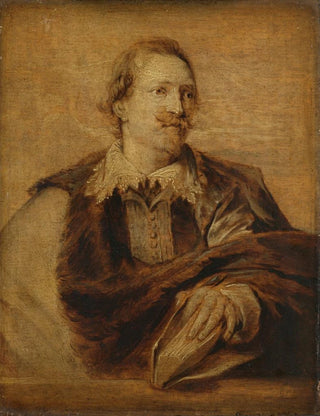Art print | Portrait of Jan Gaspar Gevaerts 1593-1666 - School of Antoine van Dyck


View from behind

Frame (optional)
Portrait of Jan Gaspar Gevaerts 1593-1666 - School of Antoine van Dyck
The "Portrait of Jan Gaspar Gevaerts 1593-1666," an emblematic work of the School of Antoine van Dyck, transports viewers into a universe where nobility and artistic virtuosity converge. This painting, created in the 17th century, embodies not only the undeniable talent of its creator but also the very essence of an era marked by refinement and sophistication. Through Gevaerts's penetrating gaze, the artwork invites us to explore the subtleties of a portrait that goes far beyond mere representation. It becomes a window into the soul of a man, a reflection of a society in full transformation.
Style and uniqueness of the work
The style of this portrait is distinguished by a remarkable mastery of chiaroscuro, a technique dear to van Dyck that allows playing with light and shadow to emphasize facial features and clothing details. The carefully orchestrated composition highlights the stature of Jan Gaspar Gevaerts, whose gaze seems to capture the viewer's attention while revealing a certain melancholy. The rich, deep colors, typical of the Baroque period, give the piece an atmosphere that is both solemn and intimate. The drapery of the robe, meticulously rendered, testifies to a concern for detail that elevates the portrait to a level of excellence. Every element, from the neutral background to the delicate accessories, contributes to this visual harmony, making this painting a key piece in the Baroque collection.
The artist and his influence
Antoine van Dyck, a pupil of Rubens, established himself as one of the most influential portraitists of his time. His innovative approach to portraiture, combining realism and idealization, marked a true break with previous conventions. Van Dyck was able to capture the essence of his subjects, placing them in dynamic and expressive poses while maintaining timeless elegance. This work, like its author, bears witness to an era where art was not content with mere representation but sought to express deep emotions.

Matte finish

View from behind

Frame (optional)
Portrait of Jan Gaspar Gevaerts 1593-1666 - School of Antoine van Dyck
The "Portrait of Jan Gaspar Gevaerts 1593-1666," an emblematic work of the School of Antoine van Dyck, transports viewers into a universe where nobility and artistic virtuosity converge. This painting, created in the 17th century, embodies not only the undeniable talent of its creator but also the very essence of an era marked by refinement and sophistication. Through Gevaerts's penetrating gaze, the artwork invites us to explore the subtleties of a portrait that goes far beyond mere representation. It becomes a window into the soul of a man, a reflection of a society in full transformation.
Style and uniqueness of the work
The style of this portrait is distinguished by a remarkable mastery of chiaroscuro, a technique dear to van Dyck that allows playing with light and shadow to emphasize facial features and clothing details. The carefully orchestrated composition highlights the stature of Jan Gaspar Gevaerts, whose gaze seems to capture the viewer's attention while revealing a certain melancholy. The rich, deep colors, typical of the Baroque period, give the piece an atmosphere that is both solemn and intimate. The drapery of the robe, meticulously rendered, testifies to a concern for detail that elevates the portrait to a level of excellence. Every element, from the neutral background to the delicate accessories, contributes to this visual harmony, making this painting a key piece in the Baroque collection.
The artist and his influence
Antoine van Dyck, a pupil of Rubens, established himself as one of the most influential portraitists of his time. His innovative approach to portraiture, combining realism and idealization, marked a true break with previous conventions. Van Dyck was able to capture the essence of his subjects, placing them in dynamic and expressive poses while maintaining timeless elegance. This work, like its author, bears witness to an era where art was not content with mere representation but sought to express deep emotions.






